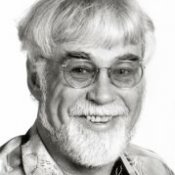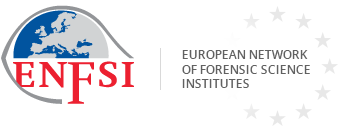2003: Michael Grieve
The late Mike Grieve (1942 – 2002) was awarded the Distinguished Forensic Scientist Award posthumously in 2003.
Biography
Mike Grieve was born in Buxton, Derbyshire as the son of a railway executive. Mike obtained a BSc (Hons) degree from the University of Durham and went on to work at the Metropolitan Police Forensic Science Laboratory (now the FSS London Laboratory) between 1964 and 1967 where he started the fibre section. A short period of working for the Pharmaceutical Society of Great Britain on the editorial staff of the Journal of Pharmacy and Pharmacology followed between 1968 -1972. Quickly tiring of reading papers about Cannabis and Amphetamines, he returned to forensic science, moving to the United States Army Criminal Investigation laboratory in Frankfurt, Germany and again established a fibres section.
After obtaining a Graduate Certificate of Education in 1976 at the University of London, he “survived” three years teaching Chemistry and Biology in a notorious south London school, reported by a reputable national newspaper to be “one of the worst in Britain”. He said he was saved by the intervention of an arsonist that incinerated the science block. Two of the few good things that came out of his teaching career in south London was his love of reggae music and his ability to lead, a quality that came to the fore in his later life.
Mike returned to Frankfurt in 1980 to run the fibre section and remained there until 1992. It was during this period that he learnt the intricacies of micro-spectrophotometry and FTIR microscopy and was also awarded the US Army Achievement Medal for Civilian Service.
The Frankfurt laboratory was threatened with closure due to the changing political situation in Eastern Europe and, in April 1992, Mike started working for yet another Government. This time he joined the Forensic Science Institute of the Bundeskriminalamt in Wiesbaden, Germany and it was in the fibre section where he carried out case-applicable R&D.
It was in the latter part of his career in Frankfurt that Mike – together with Ken Wiggins – felt the need to establish a European Fibre Group (EFG). The dream came to fruition in November 1993 with the first meeting in The Netherlands with 21 scientists attending. With Ken and Mike in the roles of Chairman and General Secretary respectively, the group has flourished ever since. It was also in 1993 that Mike was invited to join the Technical Working Group for Fibre Examination (TWGFIBE), this eventually became the Scientific Working Group for Materials (SWGMAT).
Mike wasn’t content to raise the profile of fibres in Europe alone he decided America was also a target. They loved him, a typical English gent with a booming voice who got things done by leading by example. He served on the committee for colour analysis thus helping to complete their Forensic Fibre Examination Guidelines in 1998. In 2001 Mike was particularly pleased when the EFG produced The Manual of Best Practice for Forensic Examination of Fibres. The document was probably only finished because of the enthusiasm, drive and determination that Mike had to complete any task that he started.
The EFG and SWGMAT meant that Mike had even more opportunity to follow his love of travelling. He has lectured across the length and breadth of the USA, throughout Europe, in Asia and Australia. After the lectures and meetings had finished he would always add on days of his holiday to see more of the country. If he couldn’t get to the more exotic places through work he would take holidays to such places as China, Jamaica, Trinidad and Tobago.
Mike spent most of his forensic career trying to draw attention to the potential of fibres to provide excellent evidence in criminal cases. His particular interests were: everything related to improving our knowledge about the evidential value of fibres and interpretation of casework findings; working toward international recognition of minimum standards in fibre examination; FTIR-microscopy (particularly of acrylic and modacrylic fibres); and reference collections of fibre standards. Nothing ever got thrown away be it fibre samples or information, he was a great believer in the phrase “you never know when you will need it”.
One of his main aims was to achieve his target of having had 50 papers accepted for publication, luckily he achieved this and more. It wasn’t a question of wanting to write more papers than others in the field but simply because he had so much to say about his work and wanted others to benefit from it. Probably his greatest legacy to fibre examiners will be the book “Forensic Examination of Fibres” (second edition) which he co-edited with James Robertson [ISBN 0-7484-0816-9, Taylor & Francis Ltd, 1999]. It is already referred to as the “Fibre Examiners Bible” and acknowledged worldwide as one of the best, if not the best, forensic fibre books ever produced. It was typical of Mike, only the best would do, so he went out and recruited practising scientists who were acknowledged experts in their field to write the individual chapters so how could he fail (incidentally he wrote a lot of it himself).
Mike was still working on a number of fibre related projects right up to the day he suddenly passed away in September 2002. Luckily his colleagues in Germany are completing these outstanding projects; he would have hated all his effort to be wasted. He had already once received the P.W. Allen award from the Forensic Science Society (in 1998) and just after his death it was announced that he had won it again in 2002 with his colleague Thomas Biermann.
The most important improvement for forensic sciences is that Michael Grieve provided a huge amount of basic information concerning the value of textile traces including e.g. frequencies of fibres, frequencies of fibre dyes, and that of fibre type colour combinations. Without his research fibres would not have such a high standard as trace evidence. Any forensic scientist, from no matter what discipline, could learn from him.
Between 90 and 100 people attended his funeral that took place in Hanau, Germany with European Fibre Group colleagues travelling from England, France and Switzerland as well as from all corners of Germany. He was the best forensic fibre expert in the world and was respected and liked by many. Two citations from colleagues to illustrate the feelings for Mike:
“Mike Grieve, a golden thread in the tapestry of our lives” SWGMAT September 2002 “Mike, the best colleague, friend and mentor we had” EFG September 2002
Key publications
- Grieve M.C. Fibres and Forensic Science – New Ideas, Developments and Techniques Forensic-Sci-Rev 6(1) June: 60-80 (1994)
- Grieve M.C. Another Look at the Classification of Acrylic Fibres, Using FTIR Microscopy Sci-Just 35(3) July: 179-190 (1995)
- Grieve M.C. and Biermann T.W. A Computerized Data Base of Mail Order Garments a Contribution Toward Estimating the Frequency of Fibre Types Found in Clothing. Part 1 – The System and its Operation. Forensic-Sci-Int 77(1/2) January: 65-73 (1996)
- Grieve M.C. and Bruschweiler W. A Study on the Random Distribution of a Red Acrylic Target Fibre Sci-Just 37(2) April: 85-89 (1997)
- Grieve M.C. and Biermann T. The Population of Coloured Textile Fibres on Outdoor Surfaces Sci-Just 37(4) October: 231-239 (1997)
- Grieve M.C. and Wiggins K.G. The European Fibres Group: 1993 – 1998 Sci-Just 39(1): 45-47 (1999)
- Grieve M.C. A Survey on the Evidential Value of Fibres and on the Interpretation of the Findings in Fibre Transfer Cases. Part 1 – Fibre Frequencies Sci-Just 40(3): 189-200 (2000)
- Grieve M.C. A Survey on the Evidential Value of Fibres and the Interpretation of the Findings in Fibre Transfer Cases. Part 2 – Interpretation and Reporting. Sci-Just 40(3): 201-209 (2000)
- Grieve M.C. and Wiggins, K.G. Fibres under Fire: Suggestions for Improving Their Use to Provide Forensic Evidence. J-Forensic-Sci 46(4): 835-843 (2001)
- Grieve M.C., Biermann T.W. and Davignon M. The Evidential Value of Black Cotton Fibres. Sci-Just 41(4): 245-260 (2001)
